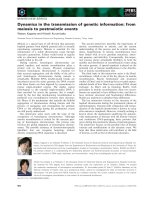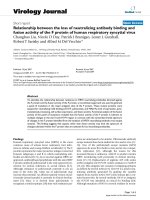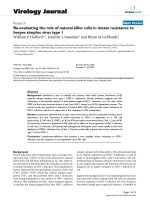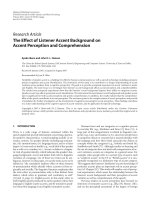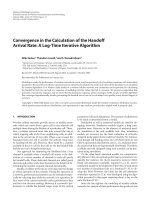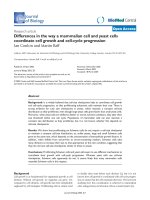Báo cáo sinh học: "Islands in the sky: the impact of Pleistocene climate cycles on biodiversity" pdf
Bạn đang xem bản rút gọn của tài liệu. Xem và tải ngay bản đầy đủ của tài liệu tại đây (503.11 KB, 4 trang )
Minireview
IIssllaannddss iinn tthhee sskkyy:: tthhee iimmppaacctt ooff PPlleeiissttoocceennee cclliimmaattee ccyycclleess oonn bbiiooddiivveerrssiittyy
Allan J Baker
Address: Department of Natural History, Royal Ontario Museum, Toronto, Ontario, Canada M5S 2C6, and Department of Ecology and
Evolutionary Biology, University of Toronto, Toronto, Ontario, Canada M5S 3B2. Email:
The general cooling of the world’s climate that began in the
Tertiary and culminated in the Pleistocene glacial cycles
from about 2.4 million years ago attracted the attention of
evolutionary biologists because of its possible effect in
changing species distributions, and thus on the speciation
of organisms. The role of these climatic fluctuations on
speciation has been much debated. At one end of the
debate, some researchers argued that the cooling suppressed
or slowed speciation, as leading-edge waves of species
populations repeatedly colonized deglaciated regions in the
interglacial periods [1,2]. This form of repeated coloniza-
tion of genetically similar individuals from the same source
populations can prevent genetic differentiation required for
speciation. Others thought that the cooling, and the barriers
of ice that divided up populations, increased the rate of
speciation; in an extreme example of this view, Ernst Mayr
wrote in his classic 1970 book [3] that “Evolutionists agree
on the overwhelming importance of Pleistocene barriers in
the speciation of temperate zone animals”.
Data from studies of North American songbirds have been
useful in showing which of these two views is correct. As
late as 1999, it was thought that species and species
complexes of North American songbirds diverged in the late
Pleistocene, which would support the view that climate
cooling increased the rate of speciation [4]. This was,
however, refuted convincingly by mitochondrial DNA data
that suggested that the emergence of new songbird species
appeared repeatedly over the past 5 million years, which
would mean a much smaller role for climate cooling in
speciation [5].
The current consensus is that some species of songbirds
originated earlier in the Pleistocene, before the glaciations
started [5-7]. It is also generally agreed that strong popu-
lation structure has evolved in songbirds and in many other
organisms [5-8]. When many genetic differences accumulate
in different populations, this structures species into isolates
that can be a precursor to speciation. However, there is
some evidence that songbird speciation might have been
completed during late glacial advances by repeated bouts of
geographical isolation, as shown by the fact that divergence
times estimated with a molecular clock in superspecies
complexes of boreal (boreal forest) superspecies of North
American birds date to the Pleistocene [9]. These complexes
are groups of very similar emergent species with adjacent
distributions that are restricted to boreal forests that were
glaciated in the Pleistocene.
AAbbssttrraacctt
Genetic studies of organisms based on coalescent modeling and paleoenvironmental data,
including a new study in
BMC Biology
of Mexican jays in the sky islands of Arizona and
northern Mexico, show that populations differentiated in multiple refugia during and after
glacial cycles.
Journal of Biology
2008,
77::
32
Published: 3 November 2008
Journal of Biology
2008,
77::
32 (doi:10.1186/jbiol90)
The electronic version of this article is the complete one and can be
found online at />© 2008 BioMed Central Ltd
UUnncceerrttaaiinnttyy iinn iinnffeerreenncceess ooff ggllaacciiaall rreeffuuggiiaa
Although there is compelling evidence that ancestral source
populations can differ genetically, there is uncertainty about
whether isolation of populations that survived and differen-
tiated in glaciated areas called glacial refugia is required to
explain genetic differentiation in extant populations [7,10].
Furthermore, inference of the number of these refugia and
the timing of isolation of populations has, until recently,
depended on the construction of gene trees, assumptions
about whether these trees reflect population trees, calibra-
tions of molecular clocks and mutation rates of the genes
being studied. All these components have uncertainties
inherent in their estimates. Innovative new studies have,
however, begun to address these uncertainties with exciting
insights into the impact of Pleistocene climatic cycles on
population differentiation and, potentially, on speciation
[10-14].
Evidence for divergence within species complexes of
songbirds in both the Pleistocene period and postglacially
has been presented in recent studies [13,14]. The yellow-
rumped warbler complex comprises two North American
migratory subspecies, the myrtle warbler (Dendroica coronata
coronata and Audubon’s warbler (D. c. auduboni), previously
thought to be separate species, and two largely sedentary
(non-migrating) forms from Mexico (D. c. nigrifrons) and
Guatemala (D. c. goldmani). The North American forms
breed in higher-latitude locations than the Mesoamerican
forms, locations that were glaciated in the past. The North
American forms hybridize with the Mesoamerican forms
only in a narrow hybrid zone in British Columbia and
Alberta, but they migrate and overlap with the Meso-
american forms in winter.
Phylogenetic analyses of three mitochondrial DNA genes
using Bayesian methods that account for phylogenetic
uncertainty have shown, surprisingly, that the two Meso-
american forms are reciprocally monophyletic, that is, that
they each form a monophyletic group that is phylo-
genetically separated from the other, whereas the North
American forms have high levels of shared ancestral poly-
morphisms [13]. Assuming a mutation rate of 2% per
million years, a coalescent approach yielded population
divergence times of about 400,000 years ago between
Mesoamerican and North American forms and 16,000 years
ago between the two North American forms. Coalescent
theory is a population genetics model that traces all the
alleles of a gene in a population sample to one ancestral
copy shared by all members of the population, which is
called the most recent common ancestor (MRCA). By apply-
ing a mutation rate for the gene it is possible to obtain the
time in years when the MRCA existed, which approximates
when the forms diverged unless they continued to exchange
alleles for some time after they separated. However, when
dated with a wide range of gene-specific mutation rates, the
uncertainty in dates was revealed, ranging up to 1.9 million
years ago between migratory and sedentary forms and up to
41,000 years ago between migratory forms.
CCoouupplliinngg ppaalleeooeennvviirroonnmmeennttaall aanndd ggeenneettiicc mmooddeelliinngg
With such imprecision in estimating divergence times, it is
difficult to test hypotheses of postglacial population
differentiation or rapid speciation using genetic data alone.
Now, however, fossil paleoecological data have emerged that
can provide an independent timeframe for recent postglacial
genetic divergence. McCormack et al. in a recent study in
BMC Biology [14] capitalized on populations of Mexican jays
(Aphelocoma ultramarina) in the ‘sky islands’ - isolated
mountain niches - of southwestern USA and northern
Mexico; these birds are ecologically tied to pine-oak
woodlands (Figure 1). Fossilized plant material in the
garbage collected in the middens of packrats (Neotoma spp.)
showed that the sky islands were connected by continuous
woodlands 18,000 years ago, at the last glacial maximum,
but as climate warmed in the past 9,000 years the woodlands
have been driven to higher elevations and have been
displaced by grassland and desert at lower elevations. The
authors [14] therefore predicted that populations of jays
should share common alleles from the ancestral population,
32.2
Journal of Biology
2008, Volume 7, Article 32 Baker />Journal of Biology
2008,
77::
32
FFiigguurree 11
The Mexican jay is a sedentary species found in pine-oak woodlands in
the sky islands in the southwestern USA and northern Mexico.
Different populations have differentiated genetically within the last
10,000 years. Photo by TJ Ulrich with permission from Visual
Resources for Ornithology, the Academy of Natural Sciences,
Philadelphia, PA.
but that each population should have a suite of ‘private’
alleles that has accumulated by mutation in the postglacial
period. That is exactly what they found in judiciously
chosen mitochondrial and nuclear loci with high mutation
rates.
McCormack et al. then subjected the genetic data for
selected population pairs to a multilocus coalescent analysis
to estimate the time of population divergence and obtained
confirmation of postglacial differentiation in the past
10,000 years or less, on the basis of the 90% highest
posterior density distributions. By fitting a model of popu-
lation splitting to explain the genetic data it is possible to
generate a large number of possible estimates of a para-
meter, which forms the posterior density distribution of
parameters, such as population divergence time. This
method also takes into account the uncertainties in the
simulation process. Additional corroboration of the
coalescent estimates was obtained from genetic distances
corrected for within-species polymorphism, with the
exception that divergence times in the western sky islands in
the Arizona ‘archipelago’ were found using this method to
range up to 81,000 years ago. The general message that
emerges from this excellent study [14] is that detection of
postglacial divergence requires large sample sizes to detect
private alleles arising from new mutations and to reduce
stochasticity in the coalescent process modeled with or
without migration.
EEccoollooggiiccaall nniicchhee mmooddeelliinngg aanndd ssttaattiissttiiccaall tteessttiinngg ooff
hhyyppootthheesseess
Other exciting developments that are helping us to under-
stand the impact of climate-induced shifts in the Pleistocene
on distribution of populations, and thus on speciation,
include the use of ecological-niche modeling to predict past
geographic distributions of ancestral source populations.
This innovative approach provides the tools for statistical
testing of hypotheses about multiple refugia by integrating
inferred past distributions with coalescent-based genetic
models [10-12]. Again, these studies are using the multiple
replicates provided by different sky-island populations in
North America and include a plant-insect herbivore associa-
tion [12] and montane grasshoppers [10,11].
Cutting-edge research from the Knowles laboratory at the
University of Michigan [10,11] using ecological-niche
modeling has provided a reconstructed historical distribu-
tion of the flightless montane grasshopper (Melanoplus
marshalli), revealing that, during glacial maxima, sky-island
grasshopper populations in Colorado and Utah must have
been displaced to lower refugial areas nearby. By coupling
this approach with genetic modeling, the authors were able
to test statistically whether the grasshoppers survived in a
single ancestral refugial population or multiple refugial
populations. Genetic modeling in a coalescent framework
not only accounts for the stochastic effects of genetic drift
in patterns of population divergence, but by simulating
DNA sequences it also incorporates the effect of mutational
variance. This makes it possible to use the amount of
lineage sorting in extant populations, as measured by the
number of deep coalescents in gene trees, to test whether
the amount of discord between the sequence data and a
two-refugia model is significantly lower than expected
under a single refugium model. Recolonization from
multiple or single refugia in interglacials could therefore
possibly explain why populations of grasshoppers have
either evolved strong geographic structure or have
speciated, whereas others have differentiated relatively
little.
By bringing more biological realism from the natural
history of organisms into ecological and genetic modeling
of population divergence, the impact of glacial cycles on
current biodiversity is being revealed in increasing detail.
An interesting aspect of several of these studies is that they
often choose to sequence the mitochondrial cytochrome
oxidase gene (COI), sometimes in tandem with multiple
nuclear genes. COI is used because it has sufficient variable
sites in the part of the gene used in DNA barcoding studies
to provide sufficient resolution for coalescent analysis. This
point is made clearly in the Mexican jay study [14] and is a
straightforward prediction of the faster coalescent times
and resolving power of mitochondrial genes [15]. Although
the current emphasis in detecting very recent (postglacial)
population divergence is on analysis of increasing numbers
of nuclear sequences to reduce variance across loci, it seems
unwise not to combine these with one or more faster
evolving mitochondrial genes, as was done so effectively
with the montane grasshoppers [10]. Ultimately, such a
unified approach is likely to help delimit species
genetically and to connect the processes of population
divergence and species recognition in a more rigorous way.
AAcckknnoowwlleeddggeemmeennttss
I thank Visual Resources for Ornithology for permission to reproduce
Figure 1.
RReeffeerreenncceess
1. Coope GR:
LLaattee CCeennoozzooiicc ffoossssiill ccoolleeoopptteerraa
Ann Rev Ecol Syst
1979,
1100::
247-267.
2. Hewitt GM:
TThhee ggeenneettiicc lleeggaaccyy ooff tthhee QQuuaarrtteerrnnaarryy iiccee aaggeess
Nature
2000,
440055::
907-913.
3. Mayr E:
Populations, Species and Evolution.
Cambridge, USA:
Harvard University Press; 1970.
4. Mengel RM:
TThhee pprroobbaabbllee hhiissttoorryy ooff ssppeecciieess ffoorrmmaattiioonn iinn ssoommee
nnoorrtthheerrnn wwoooodd wwaarrbblleerrss
Living Bird
1964,
33::
9-43.
/>Journal of Biology
2008, Volume 7, Article 32 Baker 32.3
Journal of Biology
2008,
77::
32
5. Klicka J, Zink RM:
TThhee iimmppoorrttaannccee ooff rreecceenntt iiccee aaggeess iinn ssppeecciiaattiioonn::
aa ffaaiilleedd ppaarraaddiiggmm
Science
1997,
227777::
1666-1669.
6. Avise JC, Walker D:
PPlleeiissttoocceennee pphhyyllooggeeooggrraapphhiicc eeffffeeccttss oonn aavviiaann
ppooppuullaattiioonnss aanndd tthhee ssppeecciiaattiioonn pprroocceessss
Proc Biol Sci
1998,
226655::
457-463.
7. Wenink PW, Baker AJ, Rosner H, Tilanius, MGJ:
GGlloobbaall mmiittoocchhoonn
ddrriiaall DDNNAA pphhyyllooggeeooggrraapphhyy ooff HHoollaarrccttiicc bbrreeeeddiinngg dduunnlliinnss ((
CCaalliiddrriiss
aallppiinnaa
))
Evolution
1996,
5500::
318-330.
8. Knowles LL:
TTeessttss ooff PPlleeiissttoocceennee ssppeecciiaattiioonn iinn mmoonnttaannee ggrraasssshhooppppeerrss
((ggeennuuss
MMeellaannoopplluuss
)) ffrroomm tthhee sskkyy iissllaannddss ooff wweesstteerrnn NNoorrtthh AAmmeerriiccaa
Evolution
2000,
5544::
1337-1348.
9. Weir JT, Schluter D:
IIccee sshheeeettss pprroommoottee ssppeecciiaattiioonn iinn bboorreeaall
bbiirrddss
Proc Biol Sci
2004,
227711::
1881-1887.
10. Knowles LL, Carstens BC, Keat ML:
CCoouupplliinngg ggeenneettiicc aanndd eeccoollooggiiccaall
nniicchhee mmooddeellss ttoo eexxaammiinnee hhooww ppaasstt ppooppuullaattiioonn ddiissttrriibbuuttiioonnss ccoonnttrriibbuuttee
ttoo ddiivveerrggeennccee
Curr Biol
2007,
1177::
940-946.
11. Knowles LL:
GGeenneeaallooggiiccaall ppoorrttrraaiittss ooff ssppeecciiaattiioonn iinn mmoonnttaannee
ggrraasssshhooppppeerrss ((ggeennuuss
MMeellaannlloopplluuss
)) ffrroomm tthhee sskkyy iissllaannddss ooff tthhee
RRoocckkyy MMoouunnttaaiinnss
Proc Biol Sci
2001,
226688::
319-324.
12. DeChaine EG, Martin AP:
UUssiinngg ccooaalleesscceenntt ssiimmuullaattiioonnss ttoo tteesstt tthhee
iimmppaacctt ooff QQuuaarrtteerrnnaarryy cclliimmaattee ccyycclleess oonn ddiivveerrggeennccee
iinn aann aallppiinnee
ppllaanntt iinnsseecctt aassssoocciiaattiioonn
Evolution
2006,
6600::
1004-1013.
13. Milá B, Smith TB, Wayne RK:
SSppeecciiaattiioonn aanndd rraappiidd pphheennoottyyppiicc ddiiff
ffeerreennttiiaattiioonn iinn tthhee yyeellllooww rruummppeedd wwaarrbblleerr
DDeennddrrooiiccaa ccoorroonnaattaa
ccoommpplleexx
Mol Ecol
2007,
1166::
159-173.
14. McCormack JE, Bowen BS, Smith TB:
IInntteeggrraattiinngg ppaalleeooeeccoollooggyy aanndd
ggeenneettiiccss ooff bbiirrdd ppooppuullaattiioonnss iinn ttwwoo sskkyy iissllaanndd aarrcchhiippeellaaggooss
BMC
Biol
2008,
66::
28.
15. Zink RM, Barrowclough GF:
MMiittoocchhoonnddrriiaall DDNNAA uunnddeerr ssiieeggee iinn
aavviiaann pphhyyllooggeeooggrraapphhyy
Mol Ecol
2008,
1177::
2107-2121.
32.4
Journal of Biology
2008, Volume 7, Article 32 Baker />Journal of Biology
2008,
77::
32

